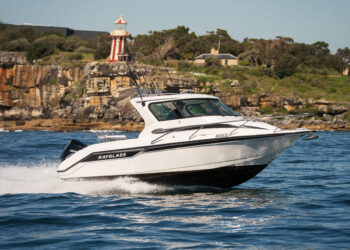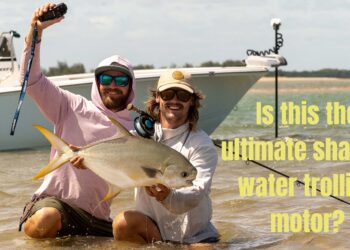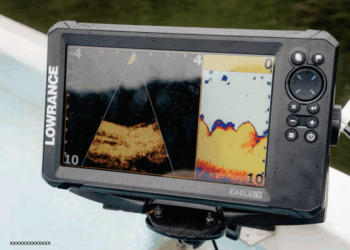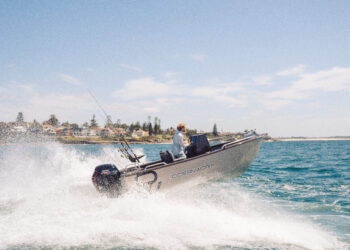Head to Head: 200HP Outboards
The second instalment of our outboard engine testing program sees the Suzuki DF200 go head to head with E-TEC and Yamaha. By Jim Harnwell.
As detailed in the February issue, Fisho has embarked on an ambitious testing schedule which will see a range of 200hp outboards fitted to the Fishing World Stabi-Craft 659 Super Cab and tested for about 50 hours.
So far we’ve put the E-TEC 200 H.O. and the Yamaha F200 to the test. This time we compare Suzuki’s DF200 with the E-TEC and the Yammie. (NOTE – The Yamaha F200 has now been superseded)
The Suzuki @ 44 hours
Suzuki’s DF200 is a 3.6 litre V6 four-stroke with a DOHC Electronic Fuel Injection system. The test unit runs a 21-inch SS prop and was installed by Batemans Bay-based Suzuki dealer Adventure Marine.
At just over 44 hours of use involving bay and offshore fishing, my considered opinion is that this is a very sweet engine! Apart from some starting issues caused by a wire not being connected properly at installation, the motor has proven 100 per cent reliable. It is without doubt the quietest of the engines tested so far, it emits no visible fumes, is mostly vibration free and possesses instant power delivery more akin to a DI two-stroke than a four-stroke.
The previous test involving the Yamaha four-stroke compared to the E-TEC revealed the Yammie to be slower out of the hole than the E-TEC. Once on the plane performance between both engines was comparable. The Suzuki didn’t quite have the get-up-and-go that’s a trademark of any decent two-stroke engine, but it wasn’t far behind the E-TEC. The Suzuki’s performance across the rev range was impressive, given the engine’s smooth power and outstanding quietness.
Performance observations
•Like the Yamaha and the E-TEC, the Suzuki maintains speed in a variety of ocean conditions without having to adjust the throttle.
•Like the other engines, it trolls well at low revs. When running at troll speed (8 knots @ 2156rpm) it is quieter than both the Yammie and the E-TEC.
•GPS measured top speed at WOT in calm water was 40 knots; the E-TEC recorded 42 knots in the same conditions; the Yamaha delivered 37 knots.
•At a cruise of about 3500 RPM (23 knots) the Suzuki proved to be noticeably quieter than both other test engines. At high speed, the engine noise of all three was about the same. At idle, the Suzuki was by far the quietest out of the three engines tested so far, followed by the Yammie and then the E-TEC. All three engines are considerably quieter than traditional two-strokes.
Ease of use
There are some differences between the Suzuki, the E-TEC and the Yamaha F200 relating to ease of use.
•The E-TEC has by far the smoothest gear shift out of the three, with the Suzuki being less “clunky” than the Yammie.
•The Suzuki’s tilt/trim hydraulic system matches the E-TEC in being marginally quieter than that on the Yammie.
•At low revs/idle, both the Suzuki and the Yamaha vibrate slightly, causing a rattle in the portside cabin window. This is not evident with the E-TEC.
•As with the Yamaha, there are no noticeable fumes or smoke from the Suzuki; a burnt oil smell is sometimes apparent from the E-TEC when trolling with the wind.
•All three engines feature innovative engine and fuel data systems to provide incredibly accurate fuel use and engine system information via dedicated gauges. For some strange reason, however, an hour gauge isn’t fitted as standard with the Suzuki, with the tacho being used to give a rough indication of usage. All three engines can be connected to compatible marine electronic units via NMEA 2000 for further customisation of data, however you need to note that connecting a Suzuki to a Lowrance sounder or GPS for NMEA data access is very difficult as neither company seems to supply the correct plugs!
•All three engines tested so far have factory backed warranties and all comply with the latest international pollution control regulations.
Size & weight
The Suzuki is midway between the Yamaha and the E-TEC in regards to size. The 55 degree V-block helps it maintain a more compact profile, especially when compared to the “imposing” Yamaha F200. At 263 kilos, the Suzuki is only marginally lighter than the Yammie (269kgs). The E-TEC comes in at 238kg, 25kg lighter than the Suzuki and some 31 kilos lighter than the Yamaha.
Fuel & oil
The Suzuki leads the pack so far in the“cruise” rev ranges of 3000rpm (18.9L per hour) and 4000rpm (25.91L per hour) compared to the Yamaha (27.7 and 30.5 LPH) and the E-TEC (29 and 44 LPH). The E-TEC retains its lead in the low rev range of idle and 1000rpm (slow trolling/jigging) while the Yamaha retains it superiority at Wide Open Throttle (WOT), beating the Suzuki by almost 5 litres and the E-TEC by 14 litres. The E-TEC retains the No.1 position for top end speed (5 knots faster than the Yammie and 2 knots faster than the Suzuki). The E-TEC is also the best performer at marlin trolling speed of 8 knots. The E-TEC uses 9.6 LPH at 1800rpm and 8 knots, beating the Yamaha by 3 LPH and the Suzuki by 1.2 LPH.
•Based on these figures, we maintain our previously published view that none of the engines tested so far has a significant advantage in regards to fuel use when used in typical offshore fishing scenarios. Most boats either troll or travel at a cruise of about 20-25 knots – it’s rare you can go flat out for extended periods out at sea – so average use between long periods spent trolling and shorter periods spent travelling would, in our view, see overall fuel use be similar. The Yammie would offer benefits if you travel more than you troll and vice versa with the E-TEC if you troll more than you travel. The Suzuki is impressive in that it performs well across the board, especially at cruise speeds. All three engines use significantly less fuel than a traditional two-stroke 200hp outboard.
•An important point to note is that the above performance and fuel data has been compiled using different propellers on each test engine: a 17-inch high cup on the E-TEC, a 19-incher on the Yammie and a 21-incher on the Suzuki. Engine performance, speed and fuel use can vary radically depending on the prop used. The props used in our tests were selected by dealers and manufacturers to provide what they regarded as “typical” offshore fishing boat performance. Fishing World invited all manufacturers involved to thoroughly “prop” the boat to ensure maximum performance. The above data needs to be assessed with that in mind. Consideration also needs to be given to engine performance/speed at stated RPMs. For example, one engine may be going slower or faster than another at the same RPM and thus using differing amounts of fuel.
•All three engines have been operated with 91 octane unleaded fuel with fuel data for the E-TEC and Yamaha provided by NMEA 2000 connections between engine EMMs and a Lowrance X37c sounder/chartplotter for maximum accuracy. The DF200 was tested using an interface with The DF200 was tested using an interface with Suzuki engine management data on a laptop computer operated by a Suzuki technician. See comparison chart opposite for detailed fuel use data.
•The Yammie and the Suzuki offer a benefit over the E-TEC in that both four-strokes have wet sumps and thus don’t require the addition of expensive XD100, a synthetic DI two-stroke oil recommended for use with E-TECs.
•The cost of oil needs to be considered when comparing fuel use between DI two-strokes such as Evinrude’s E-TEC and Mercury’s Optimax and their four-stroke competitors. The DI engines use very little oil compared to traditional two-strokes, but the cost of the new-age synthetic oils is far more than what you’d pay for a bottle of standard marine two-stroke oil. Our data indicates that the Fisho E-TEC used about 330ml of XD100, worth about $5.20, per 100 litres of fuel .
•The Suzuki requires about eight litres of engine oil when the sump oil is changed annually or once every 100 hours. Based on current prices for engine oils, this involves a cost of about $70 (or $9 a litre). The Yamaha requires six litres each service (about $54 worth of oil).
Servicing
Evinrude’s main claim to fame is that its E-TEC engines only require servicing once every three years, or 300 hours. This gives the Canadian outboard company a significant advantage over its competitors in regards to savings on servicing costs and reducing time off the water.
Like the Yamaha F200, the Suzuki DF200 requires an initial 20 hour service and then a service once a year or every 100 hours.
A typical 300 hour E-TEC service would cost about $550 (including impeller change), Nowra-based E-TEC specialist Noel Hill, from Dave Hill Marine, said. According to South Coast Yamaha dealer Abby’s Autos & Marine, a 100 hour service on an F200 would be about $450 (not including impeller). An annual service for the Suzuki is also about $450 (including impeller), according to Nowra-based Suzuki dealer Predator Boats.
Extrapolated over a three-year period, both the Yamaha F200 and Suzuki DF200 would cost about $1350 to service. An E-TEC would cost $550, resulting in an $800 saving over both the Yamaha and the Suzuki. You need to think about oil use, however, when considering these figures. The $50-$70 of oil used in a year by the Yammie and Suzuki is included in the above service cost but E-TEC XD-100 oil use isn’t.
Sum up
The Suzuki seems to possess the best of both worlds. Performance wise, it has almost as much zip as the two-stroke E-TEC but delivers the power with the refined control I previously experienced with the four-stroke Yamaha.
All in all, the quietness, smoothness, power and ease of use make it an extremely attractive engine. It and the E-TEC also have a warranty advantage over the Yamaha.
Stand-by for a test of the Mercury Optimax in an upcoming edition!
Yamaha F200
Transom Height:643mm
Weight (dry):269kg (inc SS prop)
Engine Type:24-Valve DOHC
Direct Action, 60° V6
Displacement:3352 cc
Output (hp):200
Max RPM:5500-6000
Fuel management:EFI
Alternator:12V 45 AMP
Limited Warranty:4 years
Compliance:CARB 2008
Colours:Grey Metallic Silver
RRP:$23,248*
E-TEC 200 H.O.
Transom height:635mm
Weight (dry):238kg
Engine Type:Loop Charged V6 90°
E-TEC Direct Injection
Displacement:3279 cc
Output:Factory Tuned
Max RPM:4500-5800
Fuel management:E-TEC Direct Fuel
Injection w/stratified low
RPM combustion mode
Alternator:Variable Voltage Computer
Controlled 133 Amp /
1800 watt output w/ regulator
Limited Warranty:5 Years Non-Declining
Compliance:EPA 2006 / CARB 3 STAR /
European Union 2006
Colours:Blue/White
RRP:$25,363*
Suzuki DF 200
Weight (dry):263kg
Engine type:DOHC 24-Valve
Displacement:3614 cc
Output:200hp
Max RPM:5000-6000rpm
Fuel management:Multi Point Sequential
Electronic Fuel Injection
Alternator:12v 54amps
Warranty:Limited five (5) years
Compliance:CARB ULTRA LOW 3 STAR,
EURO1, OEDA 3 Star
Colours:Black
RRP:$25,268*
*All RRPs sourced independently from dealers and correct at time of printing. Prices may have changed by time of publication.




















